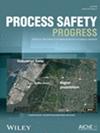加工工业中遭遇火灾事故的危险品储罐失效模式的数值研究
IF 1
4区 工程技术
Q4 ENGINEERING, CHEMICAL
引用次数: 0
摘要
油库火灾事故可能引发多米诺骨牌效应,导致多个油罐起火,造成灾难性后果。要防止大型油库遭受损失,就必须对火灾引发的多米诺骨牌事故进行动态评估。现有研究通常侧重于计算储油罐的失效时间(TTF),但忽略了失效模式的影响。本研究建立了数值模型,以探索暴露在热辐射下的均匀壁和阶梯壁储油罐的失效模式。研究考虑了燃烧油罐的火焰高度、相邻间距、壁厚和油罐容积等因素。数值模型采用固体双层火焰模型确定热辐射强度和温度,然后进行动态应力应变和屈曲分析,以获得屈曲时间(TTB)和屈服时间(TTY)。如果 TTB < TTY,则失效模式为屈曲;否则,失效模式为屈服。结果表明,在非均匀热场中的失效模式包括屈曲和屈服,阶梯壁倾向于屈曲,而均匀壁倾向于屈服。当壁厚低于临界值时,失效模式为屈服;反之,则为屈曲。这些发现有助于对油库火灾引发的多米诺骨牌效应进行风险管理和应急响应。本文章由计算机程序翻译,如有差异,请以英文原文为准。
Numerical study of failure modes of hazardous material tanks exposed to fire accidents in the process industry
Fire accidents in oil tank farms can trigger domino effects, leading to multiple tank fires with catastrophic consequences. Preventing losses in large‐scale tank farms requires a dynamic assessment of fire‐induced domino accidents. Existing research often focuses on calculating the time to failure (TTF) of storage tanks but overlooks the influence of failure modes. This study develops numerical models to explore failure modes of oil storage tanks with uniform and stepwise walls exposed to thermal radiation. Factors such as the flame heights of combustion tank, adjacent spacings, wall thickness, and tank volumes are considered. The numerical model employs a solid double‐layer flame model to determine thermal radiation intensity and temperature, followed by a dynamic stress–strain and buckling analysis to obtain time to buckling (TTB) and time to yielding (TTY). If TTB < TTY, the failure model is buckling; otherwise, the failure model is yielding. Results indicate that failure modes in nonuniform thermal fields include buckling and yielding, with stepwise walls favoring buckling and uniform walls favoring yielding. When the wall thickness is below the critical value, failure is yielding; otherwise, it is buckling. These findings support risk management and emergency response for fire‐induced domino effects in oil tank farms.
求助全文
通过发布文献求助,成功后即可免费获取论文全文。
去求助
来源期刊

Process Safety Progress
工程技术-工程:化工
CiteScore
2.20
自引率
10.00%
发文量
99
审稿时长
6-12 weeks
期刊介绍:
Process Safety Progress covers process safety for engineering professionals. It addresses such topics as incident investigations/case histories, hazardous chemicals management, hazardous leaks prevention, risk assessment, process hazards evaluation, industrial hygiene, fire and explosion analysis, preventive maintenance, vapor cloud dispersion, and regulatory compliance, training, education, and other areas in process safety and loss prevention, including emerging concerns like plant and/or process security. Papers from the annual Loss Prevention Symposium and other AIChE safety conferences are automatically considered for publication, but unsolicited papers, particularly those addressing process safety issues in emerging technologies and industries are encouraged and evaluated equally.
 求助内容:
求助内容: 应助结果提醒方式:
应助结果提醒方式:


